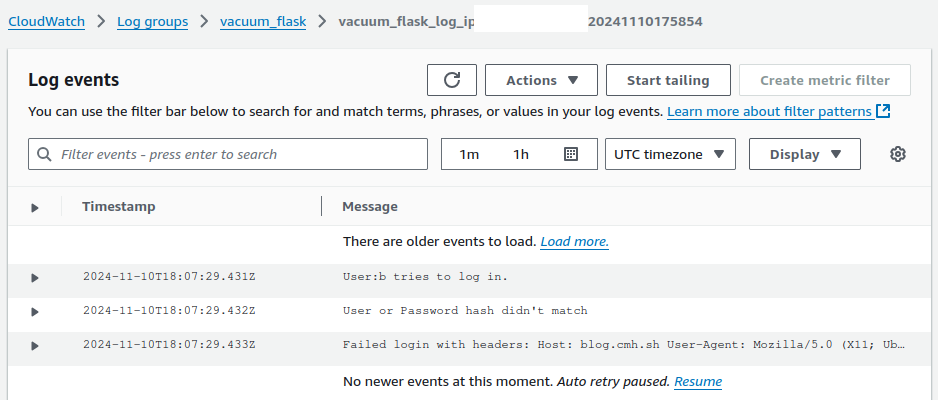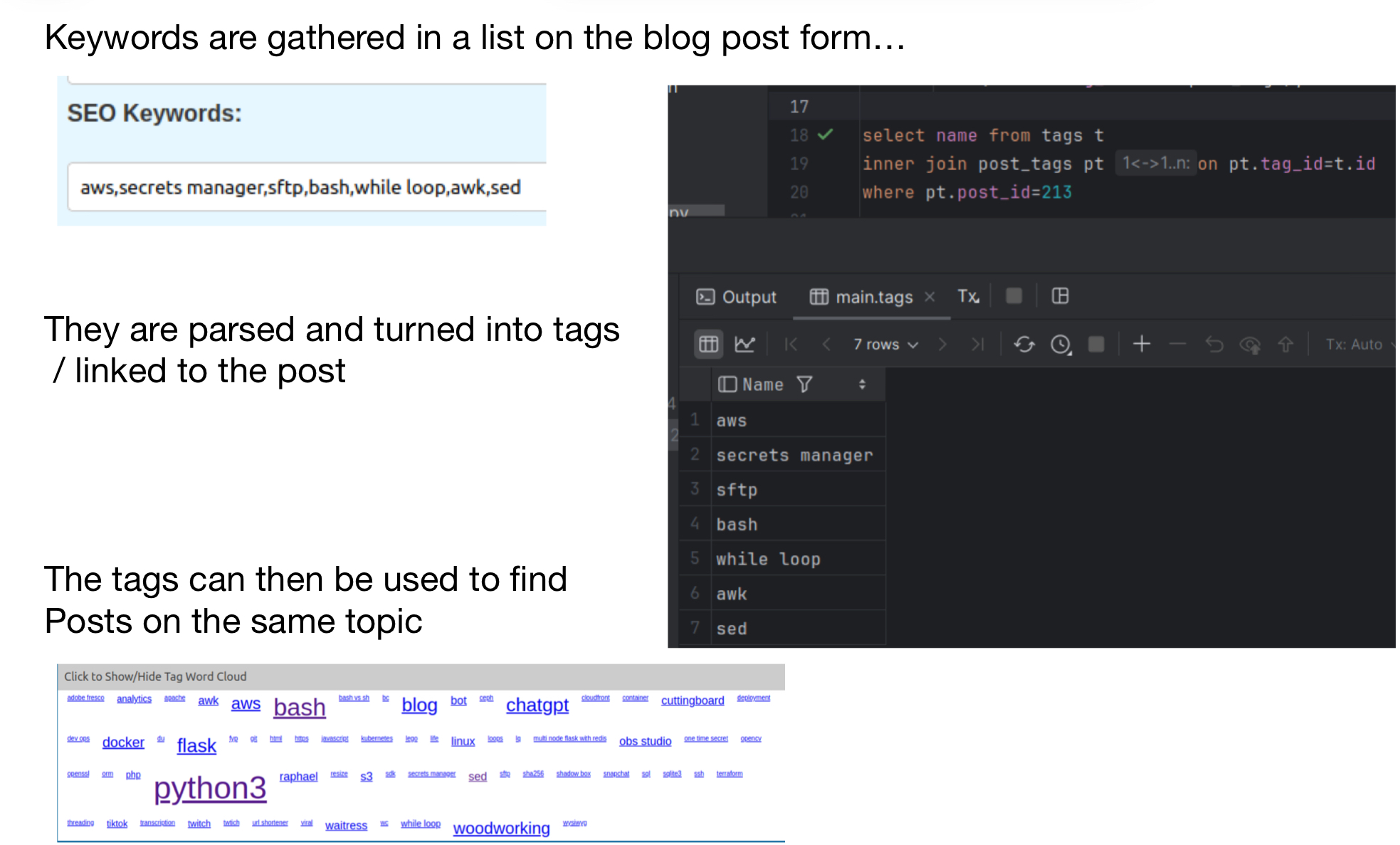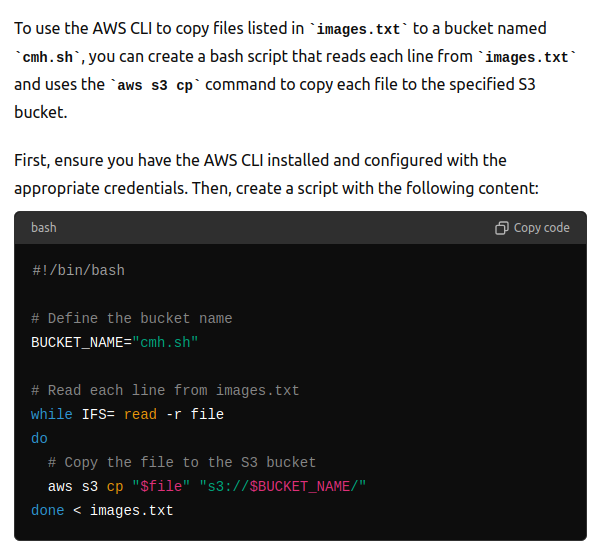The actual code to implement WatchTower in my code:
# Configure the Flask logger
logger = logging.getLogger(__name__)
cloud_watch_stream_name = "vacuum_flask_log_{0}_{1}".format(platform.node(),timeobj.strftime("%Y%m%d%H%M%S"))
cloudwatch_handler = CloudWatchLogHandler(
log_group_name='vacuum_flask', # Replace with your desired log group name
stream_name=cloud_watch_stream_name, # Replace with a stream name
)
app.logger.addHandler(cloudwatch_handler)
app.logger.setLevel(logging.INFO)
IAM permissions required
{
"Version": "2012-10-17",
"Statement": [
{
"Effect": "Allow",
"Action": [
"logs:CreateLogGroup",
"logs:CreateLogStream",
"logs:PutLogEvents",
"logs:DescribeLogStreams"
],
"Resource": "*"
}
]
}
Finishing touches
The last thing that proved to be an issue was that boto3 couldn’t find the default region in my containers. This has come up before but today was I was able to find a way around it by adding a default aws cli config file to my deployment and telling boto3 where to find it by using the environment variable AWS_CONFIG_FILE

- Redis for shared server session state
- Added health checks to the apache load balancer
- Added EFS, docker, and the required networking to the mail server.
- Fixed issue with deployment pipeline not refreshing image
- Limited main page to 8 posts and added links at the bottom to everything else so it will still get indexed.
def listen_local(self):
loop = asyncio.get_event_loop()
print("Firing off Flask")
thread1 = threading.Thread(target=lambda: self.myWebServ.run(
host=self.config_data["flask_host_ip"], port=self.config_data["flask_host_port"],
use_reloader=False, debug=True), args=()).start()
#self.myWebServ.run()
self.myWebServ_up = True
print("Listening to local Mic")
thread2 = threading.Thread(loop.run_until_complete(self.basic_transcribe()))
#loop.run_until_complete(self.basic_transcribe())
#loop.run_until_complete(self.launch_flask_server())
loop.close()
Welp, the “new” blog is live. It’s running on python 3.12 with the latest build of flask and waitress. This version of my blog is containerized and actually uses a database. A very basic concept I know. I considered running the blog on the elastic container service and also as an elastic beanstalk app. The problem with both of those is that I don’t really need the extra capacity and I already have reserved instances purchased for use with my existing ec2 instances. I’m not sure how well flask works with multiple nodes, I may have to play around with that for resiliency sake. For now we are using apache2 as a reverse https proxy with everything hosted on my project box.
Todo items: SEO for posts, RSS for syndication and site map, fixing s3 access running from a docker container. Everything else should be working. There is also a sorting issue of the blog posts that I need to work out.
FROM public.ecr.aws/docker/library/python:3.12
WORKDIR /tmp
# Add sample application
ADD app.py /tmp/app.py
ADD objects.py /tmp/objects.py
ADD hash.py /tmp/hash.py
COPY templates /tmp/templates
COPY static /tmp/static
COPY requirements.txt requirements.txt
RUN pip3 install -r requirements.txt
EXPOSE 8080
# Run it
CMD [ "waitress-serve", "app:app" ]
#!/bin/bash
docker build --tag vacuumflask .
imageid=$(docker image ls | grep -w "vacuumflask" | awk '{print $3}')
docker run --env-file "/home/colin/python/blog2/vacuumflask/.env" \
--volume /home/colin/python/blog2/vacuumflask/data:/tmp/data \
-p 8080:8080 \
"$imageid"
#!/bin/bash
destination="beanstalk/"
zipPrefix="vacuumflask-"
zipPostfix=$(date '+%Y%m%d')
zipFileName="$zipPrefix$zipPostfix.zip"
mkdir "$destination"
cp -a templates/. "$destination/templates"
cp -a static/. "$destination/static"
cp app.py "$destination"
cp Dockerfile "$destination"
cp hash.py "$destination"
cp objects.py "$destination"
cp requirements.txt "$destination"
cd "$destination"
zip -r "../$zipFileName" "."
cd ../
rm -r "$destination"
scp "$zipFileName" project:blog2
scp docker-build-run.sh project:blog2
ssh project
Next weekend I’ll need to figure out how to get it working with elastic-beanstalk and then work on feature parity.
This morning I automated my data sync between the old blog and the data storage system for the new one. This will allow me to keep up on how my newer posts will look on the pages I’m building as I slowly replace the existing functionality.
#!/bin/bash
# copy the files from my project box to a local data folder
scp -r project:/var/www/blog/blogdata/ /home/colin/python/blog2/vacuumflask/data/
# read the blog.yml file and export the ids, then remove extra --- values from stream
# and store the ids in a file called blog_ids.txt
yq eval '.id' data/blogdata/blog.yml | sed '/^---$/d' > data/blogdata/blog_ids.txt
# loop through the blog ids and query the sqlite3 database and check and see if they exist
# if they do not exist run the old_blog_loader pythong script to insert the missing record.
while IFS= read -r id
do
result=$(sqlite3 data/vacuumflask.db "select id from post where old_id='$id';")
if [ -z "$result" ]; then
python3 old_blog_loader.py data/blogdata/blog.yml data/vacuumflask.db "$id"
fi
done < data/blogdata/blog_ids.txt
# clean up blog ids file as it is no longer needed
rm data/blogdata/blog_ids.txt
echo "Done"
After getting chores done for the day I set about working on my new blog engine. This started out with getting flask templates working and after some back and forth that was sorted out. It then set in that I was repeating myself a lot because I skipped an ORM model. So I set about to write a blog class to handle loading, serialization, updates, and inserts. A round of testing later and a bunch of bugs were squashed.
A side quest today was to update all of the image paths from prior blog posts to use my CDN. I ended up using a combination of awk commands [ awk '{print $7}' images.txt > just_images.txt and awk -F '/' '{print $3}' image_names.txt > images2.txt] to get a good list of images to push to the CDN and then asked chatgpt to help me write a bash loop [ while IFS= read -r file; do aws s3 cp "$file" s3://cmh.sh; done < images2.txt ] to copy all the images.
 I’ve seen one of my more Linux savvy coworkers write these loops on the fly and it is always impressive. I streamed the first couple hours of development and encountered a number of bugs with Raphael bot that I’ll see about fixing tomorrow.
I’ve seen one of my more Linux savvy coworkers write these loops on the fly and it is always impressive. I streamed the first couple hours of development and encountered a number of bugs with Raphael bot that I’ll see about fixing tomorrow.